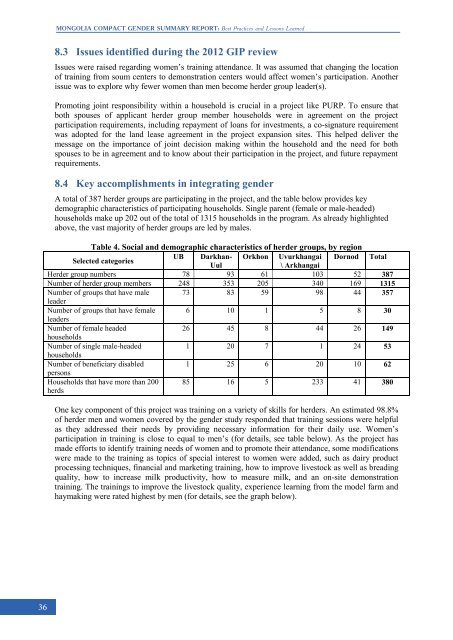Ulaanbaatar 2013
Ulaanbaatar 2013
Ulaanbaatar 2013
You also want an ePaper? Increase the reach of your titles
YUMPU automatically turns print PDFs into web optimized ePapers that Google loves.
Mongolia Compact Gender Summary Report: Best Practices And Lessons Learned8.3 Issues identified during the 2012 GIP reviewIssues were raised regarding women‟s training attendance. It was assumed that changing the locationof training from soum centers to demonstration centers would affect women‟s participation. Anotherissue was to explore why fewer women than men become herder group leader(s).Promoting joint responsibility within a household is crucial in a project like PURP. To ensure thatboth spouses of applicant herder group member households were in agreement on the projectparticipation requirements, including repayment of loans for investments, a co-signature requirementwas adopted for the land lease agreement in the project expansion sites. This helped deliver themessage on the importance of joint decision making within the household and the need for bothspouses to be in agreement and to know about their participation in the project, and future repaymentrequirements.8.4 Key accomplishments in integrating genderA total of 387 herder groups are participating in the project, and the table below provides keydemographic characteristics of participating households. Single parent (female or male-headed)households make up 202 out of the total of 1315 households in the program. As already highlightedabove, the vast majority of herder groups are led by males.Table 4. Social and demographic characteristics of herder groups, by regionSelected categoriesUB Darkhan- Orkhon Uvurkhangai Dornod TotalUul\ ArkhangaiHerder group numbers 78 93 61 103 52 387Number of herder group members 248 353 205 340 169 1315Number of groups that have male 73 83 59 98 44 357leaderNumber of groups that have female 6 10 1 5 8 30leadersNumber of female headed26 45 8 44 26 149householdsNumber of single male-headed1 20 7 1 24 53householdsNumber of beneficiary disabled1 25 6 20 10 62personsHouseholds that have more than 200herds85 16 5 233 41 380One key component of this project was training on a variety of skills for herders. An estimated 98.8%of herder men and women covered by the gender study responded that training sessions were helpfulas they addressed their needs by providing necessary information for their daily use. Women‟sparticipation in training is close to equal to men‟s (for details, see table below). As the project hasmade efforts to identify training needs of women and to promote their attendance, some modificationswere made to the training as topics of special interest to women were added, such as dairy productprocessing techniques, financial and marketing training, how to improve livestock as well as breadingquality, how to increase milk productivity, how to measure milk, and an on-site demonstrationtraining. The trainings to improve the livestock quality, experience learning from the model farm andhaymaking were rated highest by men (for details, see the graph below).36Page 36 of 80


